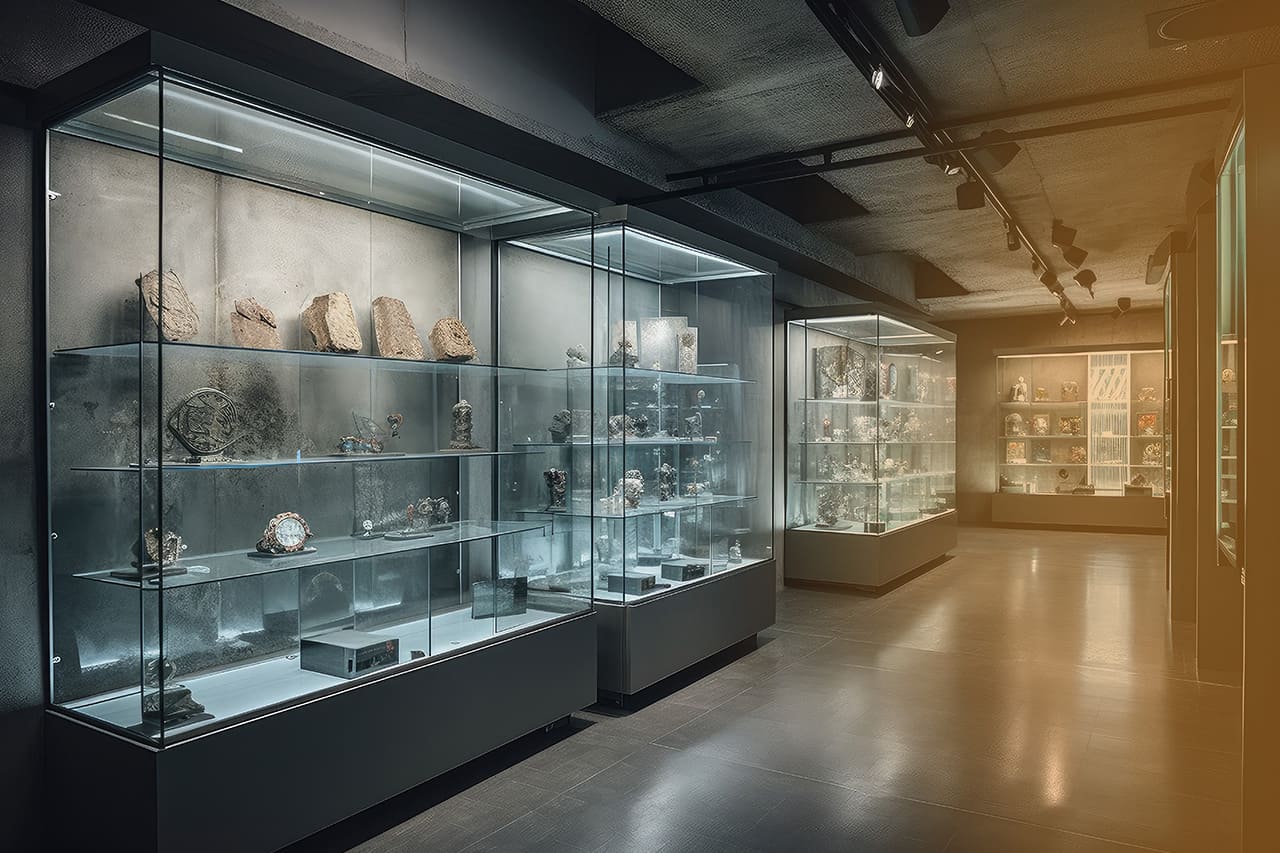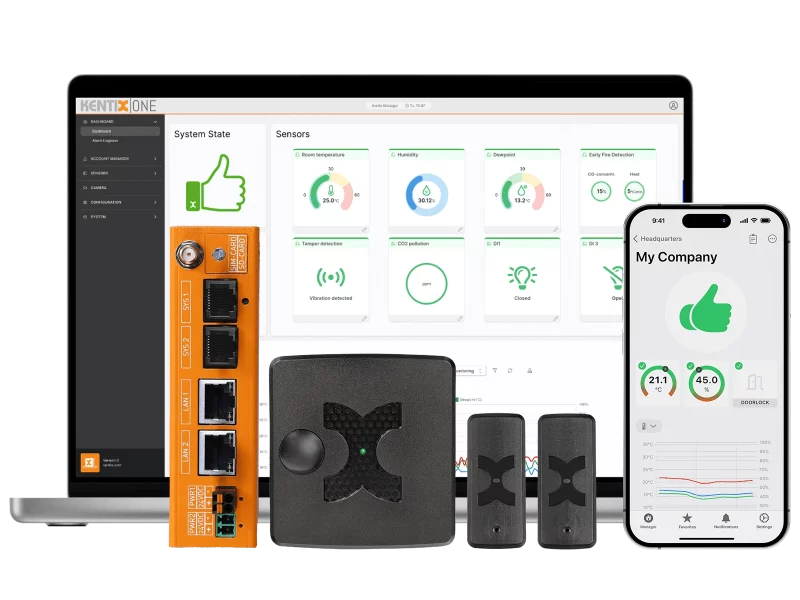They are sensitive and must therefore be protected particularly carefully against external influences: Many exhibits in museums are susceptible to cold, heat, moisture, dust or light and suffer irreparable damage as a result. The protection of exhibits is therefore of immense importance in order to preserve the exhibits for posterity. The objects must be carefully protected against all dangers from the environment. Physical security and monitoring of critical parameters is a major issue for museums and exhibitions.
Environmental monitoring to protect the exhibits
A museum is not only a place for history, art and culture, but also a treasure trove of valuable exhibits for future generations. Many of these exhibits are often extremely sensitive and are susceptible to external influences such as temperature, humidity or light. Reliable monitoring of these factors is therefore essential. This prevents damage and creates optimum conditions for the exhibits.
Why should museums monitor environmental conditions?
Here are the top five reasons why monitoring climate factors is so important for museum objects:
- Prevention of damage: Fluctuations in climate and extreme conditions permanently damage sensitive items such as historical artifacts, paintings, textiles or archaeological finds. Temperatures that are too high or too low, high humidity, exposure to light or fluctuations in these parameters cause cracks, deformation, mold and fading, for example. Continuous monitoring detects critical conditions at an early stage and provides sufficient time for countermeasures.
- Compliance with insurance requirements: Many insurance companies have special monitoring and security requirements. Regular monitoring of climate factors and documentation of the data are therefore often a prerequisite for making claims in the event of damage.
- Preservation of cultural heritage: Most of the objects in museums are unique and invaluable testimonies to history, culture and science. The correct monitoring and conservation of these exhibits preserves the cultural heritage for future generations.
- Scientific research: Research also benefits from the monitoring of climate factors in museums. This provides valuable data for research. For example, the reaction of materials to different environmental conditions or the long-term effect of certain factors on exhibits.
- Timely intervention: With reliable monitoring, museum staff react to potential problems in good time before damage occurs.
What exactly does the monitoring of the exhibits look like?
Museums, galleries and exhibitions have various options for this. Modern technologies collect data precisely and monitor the conditions in the exhibition closely. The main methods used to ensure effective monitoring include the following:
- Data loggers and sensors: These are small electronic devices that continuously collect data on temperature, humidity, light and air quality. They record this information and send it to a central system. This analyzes the data and evaluates it.
- Climate monitoring systems: Museums often rely on specialized climate monitoring systems consisting of a combination of data loggers, sensors and a central control system. These systems provide real-time data. This enables remote monitoring of the showrooms. If critical values are exceeded, staff are informed immediately.
- Handheld devices: Portable devices for on-site measurements are available for regular checks. These check the environmental conditions at various locations in the museum.
- Imaging procedures: Imaging procedures such as infrared thermography are sometimes necessary. These detect temperature differences and damp areas on the surfaces of the objects. This helps to identify hidden damage or uneven climate conditions.
- Regular inspection and logs: It is important that museum staff regularly check and record climate data to identify trends and changes. Recording the data makes it easier to identify long-term changes and potential problems.
Bochum Mining Museum finds optimal solution for its objects
The German Mining Museum in Bochum also houses numerous exhibits that are very sensitive. The insurance company required the museum to insure them for the parameters of temperature and humidity – and this was verifiable. This requires a reliable monitoring solution. This must provide precise data, record it and – according to the museum’s wishes – be as easy to install as possible. The existing system in the museum did not meet the new requirements. It also required costly and complex cabling. The museum’s IT team therefore opted for the IoT-based solution from Kentix. Its modular design was convincing. The installation of the system proved to be very simple, as the devices could be mounted and implemented without any problems. A LAN infrastructure for the MultiSensors was only required in a few places.
Kentix has completely replaced the old monitoring solution in the museum. There is now a MultiSensor-LAN-RF in a central location in each hall. Among other things, this monitors humidity and ambient temperature – important parameters for guaranteeing optimum conditions for the exhibits. In addition, several MultiSensorDOORs were placed near the sensitive objects to monitor their condition. These smaller devices also register whether (display case) doors are open or closed. The sensors are distributed flexibly and efficiently for changing objects and exhibitions. A total of over 50 MultiSensors are in use here.
The MultiSensor: numerous functions in one device
The MultiSensor impressed the museum with its diverse features, which are combined in just one single device:
- Versatile detection of climate factors: The Kentix MultiSensor monitors several climate factors simultaneously, including temperature, humidity, air quality (e.g. CO2 concentration) and air pressure. This comprehensive recording enables museums to keep an eye on all the important environmental parameters that are crucial for the preservation of their exhibits. Depending on the model, the MultiSensor even detects impending fires well in advance (more on early fire detection)
- Easy installation: The MultiSensor from Kentix is easy to mount on walls or ceilings, which makes installation simple and flexible. Wireless connectivity facilitates setup and integration into existing surveillance systems.
- Real-time monitoring and notifications: The MultiSensor continuously provides real-time data via its sensors. If predefined limit values for temperature, humidity or other parameters are exceeded, the system automatically sends warning messages or alarms by e-mail or push SMS. In this way, museum staff are immediately informed of critical conditions.
- Compact design: The Kentix MultiSensor is housed in a compact casing that blends discreetly into its surroundings without detracting from the aesthetics of the exhibition space.
- Remote monitoring: By networking the sensors, museums can manage and monitor their systems centrally. This enables convenient remote monitoring and control from different locations.
- Expandability: The MultiSensor can be expanded and combined with all other Kentix devices. This creates a comprehensive security and monitoring system for the entire museum.
Comprehensive monitoring of museum objects is simple and straightforward
Even though Kentix’s origins – its home, so to speak – lie in the server room and its monitoring, the possibilities opened up by IoT technology are almost limitless. The monitoring solution is used practically everywhere where environmental conditions need to be monitored or access needs to be controlled and regulated. The example of the German Mining Museum in Bochum is an impressive demonstration of the wide range of possible applications for Kentix monitoring solutions.

